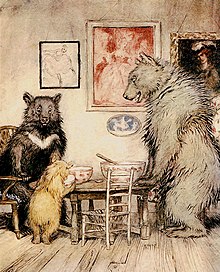Three Bears
| "Goldilocks and the Three Bears" | |
|---|---|

Illustration by Arthur Rackham
|
|
| Author | Robert Southey |
| Country | United Kingdom |
| Language | English |
| Genre(s) | Fairy tale |
| Published in | The Doctor |
| Publication type | Essay and story collection |
| Publisher | Longman, Rees, etc. |
| Media type | |
| Publication date | 1837 |
"Goldilocks and the Three Bears" and the older still "The Story of the Three Bears" are two variations of a 19th-century fairy tale. The story tells of a little blonde, curly-haired girl named Goldilocks who enters the forest home of three bachelor bears whilst they are away. She sits in their chairs, eats some of their porridge, and falls asleep in one of their beds. When the bears return and discover her, she starts up, jumps from the window, and is never seen again.
What began as a fearsome oral tale became a cosy family story with only a hint of menace. The story has elicited various interpretations, and adaptations have appeared in film, opera, and other media. "The Story of the Three Bears" is one of the most popular fairy tales in the English language.
In Southey's tale, three anthropomorphic bears – "A little girl named Goldilocks, goes for a walk in the forest and comes upon a house where she enters and finds to her delight three bowls of porridge. The first one she tastes is too hot, the next too cold but the third one just right so she eats it all up. Goldilocks finds the three different size chairs where she tries them out and finds the first one too hard, the next too soft, and then the little one just right but it breaks when she sits in it. As she wanders in the home she finds three beds and tries them out. The first bed is too hard, the next too soft but the third is just right and she curls up and falls asleep. Meanwhile the owners come home who happen to be three bears, Papa, Mama and little baby bear. Much to their surprise they discover the outcome of what Goldilocks has done to their porridge, chairs and finally their beds. Goldilocks wakes with a fright when she sees and hears the bears; she jumps from the bed and runs away as fast as she can.
The story was first recorded in narrative form by British writer and poet Robert Southey, and first published anonymously as "The Story of the Three Bears" in 1837 in a volume of his writings called The Doctor. The same year Southey's tale was published, the story was versified by George Nicol who acknowledged the anonymous author of The Doctor as "the great, original concocter" of the tale. Southey was delighted with Nicol's effort to bring more exposure to the tale, concerned children might overlook it in The Doctor. Nicol's version was illustrated with engravings by B. Hart (after "C.J."), and was reissued in 1848 with Southey identified as the story's author.
...
Wikipedia
